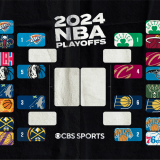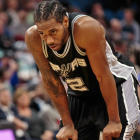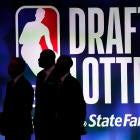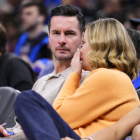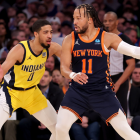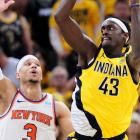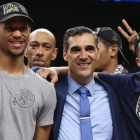There's something really weird going on with the Spurs.
On the surface, there's absolutely nothing wrong. They're 19-5, with the seventh-best offense and 10th-best defense in the league. Even after the loss at Chicago last Thursday night, they've won 14 of their past 16 games and have to be the odds-on favorite to win the Southwest Division again and secure home court in the first round, even with the emergence of Houston.
So we're not discussing whether the Spurs are a good team. They clearly are. But when you hope to contend with the Warriors, you're judged by different standards. Specifically, it's the defense that is looking like a bit of a red flag, even though, again, the numbers look pretty good overall.
Kawhi Leonard's numbers, on the other hand, tell a different story.
And it's a strange one to follow.
A troubling trend
San Antonio sported the league's best defensive rating last season, has been top-five each of the past four seasons and Leonard is the two-time Defensive Player of the Year. How could defense be anything but a strength for the Spurs?
This chart below is the Spurs' defensive rating with each player on and off court (for players who have played at least 150 minutes) -- with the defensive ratings representing the amount of points the Spurs give up per 100 possessions in those situations. The higher the number in the far right column, the worse the Spurs are defensively with that player on the floor.
Take a close look at that number in red.
| OFF | ON | |||
| MIN | DefRtg | MIN | DefRtg | |
| Kawhi Leonard | 322 | 91.5 | 782 | 106.3 |
| Tony Parker | 719 | 99.5 | 385 | 106.0 |
| Pau Gasol | 526 | 97.3 | 578 | 105.8 |
| LaMarcus Aldridge | 414 | 96.1 | 690 | 105.3 |
| Danny Green | 722 | 101.2 | 382 | 102.5 |
| Manu Ginobili | 732 | 102.7 | 372 | 99.8 |
| Nicolas Laprovittola | 952 | 101.5 | 152 | 102.5 |
| Davis Bertans | 908 | 102.2 | 196 | 99.6 |
| David Lee | 719 | 103.1 | 385 | 99.1 |
| Patty Mills | 559 | 105.4 | 545 | 98.0 |
| Kyle Anderson | 829 | 102.2 | 275 | 100.0 |
| Jonathon Simmons | 671 | 110.2 | 433 | 93.1 |
| Dewayne Dedmon | 858 | 105.4 | 246 | 88.7 |
That's right, the Spurs' defense gives up the most points per 100 possession, is at its worst statistically, when Leonard is on the floor. I know that sounds crazy, but those are the numbers. San Antonio is significantly worse -- 14.8 points per 100 possessions, to be exact -- when he's on the floor. In other words, they go from downright bad on defense to elite when Leonard goes to the bench.
I can hear you all screaming: "This is the problem with analytics! Defensive metrics are flawed! It's about his teammates! This stat means nothing!"
I hear you, and you're right, to a degree. But this trend is too unusual, over a full quarter of the season, for there not to be something weird going on.
Before we look at why, we need to look at a few more defensive metrics for a complete picture. After all, we know Leonard is a great defender. Even people who don't regularly watch basketball can see Leonard's length, positioning, intensity and freakish alien tentacle hands suffocate possessions and conclude he's a good defender.
And yet, the numbers just get worse the deeper you look.
In addition to that really bad overall defensive rating, opponents are shooting 3.8 percent better than their average on the 9.5 shots that Leonard is contesting per game, per NBA.com's tracking data. Furthermore, the defensive rating of each one of the Spurs' eight rotation players gets worse with Leonard on the court, often by double-digits.
And Leonard's personal numbers are not appreciably affected by who he plays with. In fact, he gets better while paired with four of the eight, and only marginally worse with the other four (he is 2.2 points per 100 worse alongside LaMarcus Aldridge, for instance). Here, take a look:
Numbers are points per 100 possessions allowed. So higher is worse. You want the number sub-102. pic.twitter.com/b2rboMFWoL
— Hardwood Paroxysm (@HPbasketball) December 9, 2016
All this suggests that it is not Leonard's teammates who are dragging him down, but the other way around. If you want at least some variation of a bottom line, in individual defense, Leonard is only 53rd percentile via Synergy Sports. He was 86th percentile last season.
So we've reached an impasse. We know Leonard is an elite defender. We know he's still locking up whoever he is facing. So how do we explain these numbers, the somewhat small sample size notwithstanding?
Is it possible that Leonard is, in fact, too good a defender?
Kawhisolation
During the Bulls' 95-91 victory over the Spurs, Chicago started out hot. The Bulls shot 50 percent in the first 10 minutes and 50 seconds. Leonard was on the court the whole time, and his primary assignment, Jimmy Butler, was 0 for 3 with a turnover caused by Leonard.
The other four Bulls were 10 of 17. Alone, that isn't terribly noteworthy. That's one quarter of a random game. What happened on those 10 scoring plays, however, is very interesting.
Butler didn't touch the ball. Not once. Didn't get it on a handoff. Didn't take a pass and keep the ball moving. In fact, Butler hardly moved. This is often what is happening with Leonard, who's so good defensively that teams are neutralizing him by effectively removing his man from the equation, putting him out on an island in one-on-one defensive isolation and forcing the other Spurs to defend for themselves.
Here's the first possession for Chicago. Don't watch the ball. Watch Butler.
Second scoring play. Again, don't watch the ball. Watch Butler.
Later in the half ...
All game long it went this way, and the few times Butler tried to generate offense, he failed, because Leonard was guarding him 80 percent of the time. Butler went 4 of 14 with three turnovers.
But the Bulls had a 107 offensive rating when Butler and Leonard were on the floor together, which is stellar.
The Spurs eventually switched it up and put Leonard on Dwyane Wade, who had been carving them up. So Butler backed down his defender, drawing the eyes of Leonard looking to help over, and Wade got an easy cut when Leonard fell asleep for a rare moment.
At one point, the Bulls kept Butler this high in the court the entire time. Jimmy Butler, just hanging out near half-court.
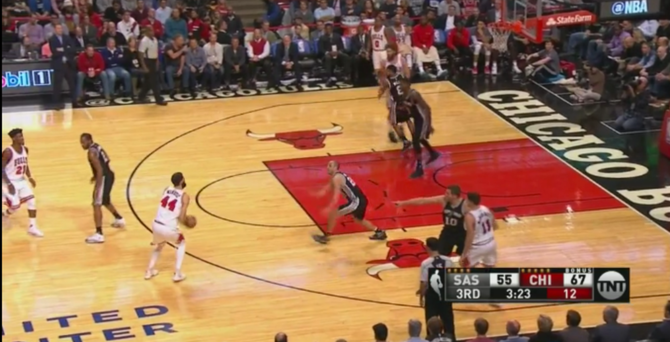
When the Spurs switched Leonard onto Wade, Wade responded by standing so deep in the corner that you can't even see him in the picture below.
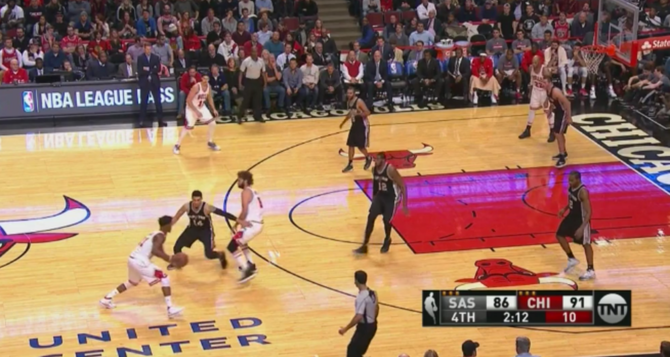
By doing this, you neutralize Leonard. He can't guard Robin Lopez, he's not big or strong enough, so if you take your wing out of the play, which subsequently removes Leonard, you end up playing 4 on 4 in a lot of space against four average-to-below-average Spurs defenders.
Some might say this is a strategy that only a team like the Bulls can employ, because they have Wade to make up for the effective absence of Butler, or vice versa. But what about the Magic, who upset San Antonio two weeks ago?
Leonard started out matched up on Aaron Gordon, who finished 5 of 9 for 11 points, but was 1 of 5 in the first quarter when Leonard was all over him. And lookee here:
And again, on this one, Leonard is so far in the corner he can't really disrupt Elfrid Payton on an easy layup.
Of course, with Evan Fournier going for seven first-half points with two assists on his way to 13 points and seven assists, the Spurs switched and put Leonard on Fournier to disrupt the offense.
So Gordon scored.
Or how about the Wizards, who hung in until the end vs. the Spurs in a loss?
You get my drift.
Watching the Spurs' defense, the same pattern emerges. The opponent takes whoever Leonard is guarding to the corner and plays 4 on 4, often to great results. Much of this is because Leonard shares the court with Tony Parker and Pau Gasol, who simply can't contain in the pick and roll. This is the key component: As good as Leonard is, you can neutralize him. This wasn't possible in previous years because the rest of the Spurs' defense was so good. But now, with certain lineups, there are real weaknesses.
I looked at the top 11 lineups with the most minutes played vs. the Spurs this season. Of those lineups, eight had positive net ratings and high offensive ratings. Here are the small forwards in those lineups:
Otto Porter, Rudy Gay, Andrew Wiggins, Luc Richard Mbah a Moute, Trevor Ariza, Jabari Parker, Harrison Barnes, Wesley Johnson, Joe Johnson and Luke Babbit.
Notice a pattern?
Wiggins had a negative net rating, because he's central to the Wolves offense and was guarded by Leonard. Same with Jabari Parker. The rest are players that aren't essential to the offense. Maybe that's circumstantial and random, but it's also very interesting. As a counter-example? Giannis Antetokounmpo had a 91 offensive rating, nine points below his season average.
So we know the Spurs have struggled with Leonard on the floor, and we can at least suspect this is largely because he's being frozen out defensively on several possessions and therefore can't cover for his teammates' inadequacies. But what does it mean?
Takeaways
This is not rocket science: "Hey, why don't we not give the ball to the guy guarded by a two-time defensive player of the year?" That's not exactly reinventing the wheel, and some of it is as simple as "some plays the guy you're defending is not involved," but it is notable. The biggest reason this stands out is because, unlike some other defenders like Draymond Green who can switch onto any frontcourt or backcourt player, or Rudy Gobert, who will always make his impact known with his shot blocking and rim protection, Leonard can't be maximized because of his teammates' limitations. From a broader league perspective, that's my biggest takeaway: If you're getting an early read on Defensive Player of the Year, Leonard is not making as much of an impact this year as other players are.
It really is the other guys: The Spurs are 26th in the league in points per possession created by the pick-and-roll ball-handler. Tony Parker is in the 6th (!!!) percentile, Gasol the 30th percentile, Aldridge the 37th percentile. This does not bode well for their future. Those are not players who are going to suddenly grow and develop. They can get better as a unit, certainly, but there were warning signs about these combos going into the year, but we assumed the Spurs would do well enough to figure them out. They've figured out all the combinations around them, which is why they all have better defensive ratings than Leonard and still have, again, the 10th-best defense. But in a playoff environment? This is worrisome.
Lineups play a huge role: The Spurs' starters have a good defensive rating of 101.5 together. And they play against the best players most often. Leonard is always on the floor when the opponent's best weapons are on the court. The Spurs' bench players can feast on bench lineups but Leonard is always getting the toughest lineups to play against, and there's no way to factor for all that, yet.
It hasn't mattered ... yet: To beat a dead horse, the Spurs are 10th in defense with the league's second-best record. They are top-10 in offense. Leonard, in particular, has been MVP-level good offensively. He's so efficient in every area it's borderline insane. He's an elite player and his control of the game has never been higher. This isn't about whether Leonard is a good defender or not; he clearly, obviously is. It's about the fact that the Spurs have a problem which doesn't matter now but will matter a whole lot when they get into a playoff series vs. the Clippers, Rockets or Warriors, any one of which can sacrifice their small forward's scoring and carve up the rest..
There are good defensive combos, still: Patty Mills and Dewayne Dedmon, in particular, have been great, and that's evident when you watch them. Don't be surprised if those guys play big minutes in the playoffs.
It's still early: Many have suggested this is just early season noise, and that as time goes on, this will fix itself. That's a fair instinct, and it was mine at the outset before I started seeing all the different ways the defensive metrics are subpar. There are real issues that match the eye test. They can improve in all these things, but it would be wrong to chalk this up as random when there are identifiable patterns.
The biggest question is about when Leonard's off the court: The defense is bad when Leonard's on the court. But why is the defense so much better when Leonard's not playing? The lineups thing makes sense, in terms of playing starters vs. playing bench guys. But it's still baffling that these other units, some of which feature Gasol and Parker, are still defending well. How does the offense change their habits when they're not facing Leonard? That's the biggest thing we still don't understand.
There are solutions, but they're tough: Say the Spurs face the Clippers in a second-round matchup. Leonard struggles with big powerful power forwards like Blake Griffin, and Danny Green always draws the primary assignment on point guards like Chris Paul. Even if you put Leonard on J.J. Redick, there's still the problem of the rest having to guard two of the best pick-and-roll combos in the league. Playing zone is rare in the NBA, but the Spurs have run it the second-most of any team in the league, via Synergy Sports. They also haven't had great success with it, giving up 1.0 points per possession (on a measly 27 possessions), so it doesn't seem to be the answer.
What do you do when your defender is so good the offense simply concedes defeat and makes your half-court game a 4-4 match, eliminating his ability to wreak the kind of havoc he's capable of? The Spurs will have to come up with an answer to that question.
You'd think taking away one of the opponent's offensive players completely would be a blessing, but in the case of the Spurs, it almost seems that because the rest of their defenders aren't quite good enough, Leonard may be too good for his own good.








